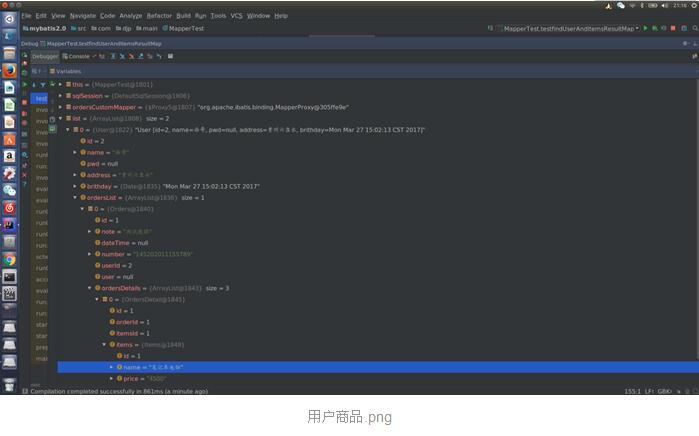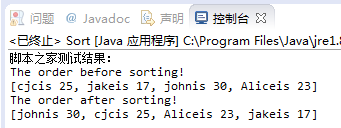1.同以前一样,首先给一个使用多对多的需求,
要查询用户以及用户所购买的商品信息,经过分析用户和商品数据库级别没有任何关系,用户和商品需要建立关系,要通过订单,订单明细建立关系。根据这个需求,可以分析出需要查询的主表为:
查询主表:用户表
查询关联表:由于商品和用户没有关系,通过订单和订单明细进行关联,所以得出关联表是:orders订单表,orderdetail订单明细表,items商品表。这样的话,sql该如何去写?这样写:
|
1
2
3
4
5
6
7
8
9
10
11
12
13
14
15
16
17
18
19
|
select
orders.*,
t_user.id user_id,
t_user.address,
t_user.name,
t_user.brithday,
orderdetail.id orderdetail_id,
orderdetail.orderid,
orderdetail.itemsid,
items.id items_id,
items.name items_name,
items.price items_price
from
orders,
t_user,
orderdetail,
items
where
orders.userid=t_user.id and orderdetail.orderid=orders.id and orderdetail.itemsid = items.id
|
为了方便映射,适当加上别名,上面就是写好的大sql,这sql语句是越来越大了,但不要害怕,待会做映射一个个来做,只要方法得提是很简单的。
2.编写映射文件分析:
现在的主表是user,所以将用户 的信息映射到user中,一个用户可以创建多个订单,所以在user属性中添加list<orders> orderlist 属性,这和hibernate越来越像了哈,然后将用户创建的订单映射到orderlist,中一个订单可以包括多个订单明细,所以在orders中添加订单明细列表属性:list<orderdetail> orderdetails ,一个订单明细只包括一个商品信息,所以在ordersdetail中添加商品items 属性。
user.java代码如下:
|
1
2
3
4
5
6
7
8
|
public class user {
private int id;
private string name;
private string pwd;
private string address;
private date brithday;
private list<orders> orderslist;//看这里 用户创建的订单列表
}
|
orders.java代码如下:
|
1
2
3
4
5
6
7
8
|
public class orders {
private int id;
private string note;
private date datetime;
private string number;
private int userid;
private user user;
private list<ordersdetail> ordersdetails;//一个订单包括多个订单明细
|
ordersdetail.java代码如下:
|
1
2
3
4
5
|
public class ordersdetail {
private int id;
private int orderid;
private int itemsid;
private items items;//一条订单明细包括一条商品信息
|
到这里,pojo类之间的关系就搭建好了,接下来写mapper.xml
代码如下(注意看代码里的注释):
|
1
2
3
4
5
6
7
8
9
10
11
12
13
14
15
16
17
18
19
20
21
22
23
24
25
26
27
28
29
30
31
32
33
34
35
36
37
38
39
40
41
42
43
44
45
46
47
48
49
50
|
<!--查询用户所购买的商品信息resultmap-->
<resultmap id="useranditemsresultmap" type="com.djp.pojo.user">
<!--配置用户信息-->
<id column="user_id" property="id"/>
<result column="address" property="address"/>
<result column="name" property="name"/>
<result column="brithday" property="brithday"/>
<!--配置用户创建的订单信息,一个用户创建了多个订单-->
<collection property="orderslist" oftype="com.djp.pojo.orders">
<id column="id" property="id"/>
<result column="note" property="note"/>
<result column="datetime" property="datetime"/>
<result column="userid" property="userid"/>
<result column="number" property="number"/>
<!--配置订单明细信息 一个订单包含多个订单明细-->
<collection property="ordersdetails" oftype="com.djp.pojo.ordersdetail">
<id column="orderdetail_id" property="id"/>
<result column="orderid" property="orderid"/>
<result column="itemsid" property="itemsid"/>
<!--配置商品信息 一个明细包括一个商品-->
<association property="items" javatype="com.djp.pojo.items">
<id column="items_id" property="id"/>
<result column="items_name" property="name"/>
<result column="items_price" property="price"/>
</association>
</collection>
</collection>
</resultmap>
<!--查询用户所购买的商品信息-->
<select id="finduseranditemsresultmap" resultmap="useranditemsresultmap">
select
orders.*,
t_user.id user_id,
t_user.address,
t_user.name,
t_user.brithday,
orderdetail.id orderdetail_id,
orderdetail.orderid,
orderdetail.itemsid,
items.id items_id,
items.name items_name,
items.price items_price
from
orders,
t_user,
orderdetail,
items
where
orders.userid=t_user.id and orderdetail.orderid=orders.id and orderdetail.itemsid = items.id
</select>
|
有了之前一对多的映射,类比写这个就比较简单了;这里不能使用继承,因为你发现使用继承没法套用了。所以只能老实的写完。
接下来在接口中添加一个方法,为查询用户所购买商品信息
|
1
2
3
4
5
6
7
|
public interface orderscustommapper {
/**
* 查询用户所购买的商品
* @return
* @throws exception
*/
list<user> finduseranditemsresultmap() throws exception;
|
最后一步,写测试类:
|
1
2
3
4
5
6
7
8
9
10
11
12
13
14
15
16
17
|
/**finduseranditemsresultmap
* 查询用户所购买的商品信息
*/
@test
public void testfinduseranditemsresultmap() {
try {
system.out.println("start.................");
//通过得到的sqlsessionfactory打开回话sqlsession
sqlsession sqlsession = sqlsessionfactory.opensession();
//通过会话得到用户的代理
orderscustommapper orderscustommapper = sqlsession.getmapper(orderscustommapper.class);
list<user> list = orderscustommapper.finduseranditemsresultmap();
system.out.println("end.................");
} catch (exception e) {
e.printstacktrace();
}
}
|
运行,结果如下:
用户商品.png可以看到我展开的列表,是不是想要的数据都出来了;
总结:
到这里可能有人会觉得这个怎么比hibernate中的多对多还麻烦,那么,现在如果有这么一个需求,查询用户所购买的商品信息明细清单(用户名,用户地址,购买商品名称,购买商品时间,购买商品数量),这个时候应该使用resultmap还是resultype,这个时候会发现,针对上面的需求,就是用resulttype将查询到的信息映射到一个扩展的pojo中,很好用,加属性就行了,这样的话就可以很简单地实现明细清单的功能,比如话费账单,张三几点几分给谁打电话,张三几点几分打电话给谁,没必要去重复记录。所以,要根据需求来,并非所有的一对多都是上面的resultmap那种查询。使用resultmap是针对那些查询结果有特殊要求的功能,比如映射成list中还包括多个list。
一对多是多对多的特咧:查询用户购买商品信息,用户和商品是多对多关系。
需求1:查询字段:用户账号,用户名称,用户性别,商品名称,商品价格(最常见)。企业开发中常见的明细表,用户购买商品明细表等。
方法:使用resulttype将上面商品输出
需求2:查询字段:用户账号,用户名称,购买商品数量,商品明细(鼠标移动到上面显示明细)
方法:使用resultmap将用户所购买的商品明细映射到user中。
对resultmap的大总结:
resulttype:
作用:将查询结果按照sql列名和pojo属性名一致映射到pojo中
场合:常见的一些明细记录的展示,比如用户购买商品的明细,将关联查询的信息全部展示在页面时,此时用resulttype将每一条记录映射到pojo中,在前端页面遍历list即可。
resultmap:
使用association和collection完成一对一和一对多的高级映射(对结果有特殊要求)。
association:
作用:将关联查询的信息映射到一个pojo中
场合:为了方便查询关联信息可以使用association将关联订单信息映射为用户对象的pojo属性中,比如:查询订单关联查询用户信息。
collection:
作用:将关联查询用户信息映射到一个list集合中
场合:为了方便查询遍历关联信息可以使用collection将关联信息映射到list集合中,比如:查询用户权限范围模块以及模块下的菜单,可以使用collection将模块映射到list中,将菜单列表遍历即可!
以上这篇基于mybatis高级映射多对多查询的实现就是小编分享给大家的全部内容了,希望能给大家一个参考,也希望大家多多支持快网idc。
原文链接:http://www.jianshu.com/p/58b92011130b
相关文章
- ASP.NET自助建站系统中的用户注册和登录功能定制方法 2025-06-10
- ASP.NET自助建站系统的域名绑定与解析教程 2025-06-10
- 个人服务器网站搭建:如何选择合适的服务器提供商? 2025-06-10
- ASP.NET自助建站系统中如何实现多语言支持? 2025-06-10
- 64M VPS建站:如何选择最适合的网站建设平台? 2025-06-10
- 2025-07-10 怎样使用阿里云的安全工具进行服务器漏洞扫描和修复?
- 2025-07-10 怎样使用命令行工具优化Linux云服务器的Ping性能?
- 2025-07-10 怎样使用Xshell连接华为云服务器,实现高效远程管理?
- 2025-07-10 怎样利用云服务器D盘搭建稳定、高效的网站托管环境?
- 2025-07-10 怎样使用阿里云的安全组功能来增强服务器防火墙的安全性?
快网idc优惠网
QQ交流群
-
如何在 Linux 中查找映射到 VxVM 磁盘的 SAN LUN
2025-05-27 102 -
企业网站云服务器租赁:VPS主机、独立服务器与网络安全保障方案
2025-06-04 44 -
2025-05-27 92
-
2025-05-27 59
-
2025-06-04 53












